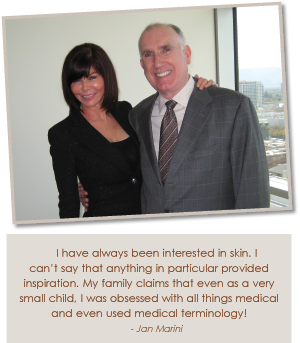Being dynamic and offering wow in your professional services comes from creating your personal skill set and developing yourself in the here and now.
Continue to read trade magazines. Attend trade events and meetings to network with aestheticians like you, dedicated to actively participating in and staying at the top of the industry.Spend a day shadowing a dermatologist and partner with him or her if you find your philosophies and treatments are complementary.Dr. Marcia Glenn, founder and director of Odyssey MediSpa, Marina del Rey, Calif., recommends aestheticians: 1) develop a skill set, 2) keep up with the regular processes and practices of your board by working within the scope of practice for your license, and 3) keep up with the industry, it is ever changing.Seek and you shall find how to wow yourself and your clients in your professional skin care treatments.
Use of targeted products formulated with new performance ingredients is one of the technological sciences behind an excellent professional treatment.The term performance ingredient is used to differentiate an ingredient from an active and an inactive ingredient.An active ingredient is a drug ingredient and an inactive ingredient is a cosmetic ingredient.The ingredient technologically designed to offer a desired result is identified as the performance ingredient offering a purposeful action in the product formulation.This is part of the scientific wow factor at work.Now how do you determine which targeted wow product to use?
Value in the Client’s Story
Ensuring a safe and effective professional skin care experience begins with an understanding of any treatment and ingredient contraindications.In our politically aware society, there are comfortable ways to explore a client’s medical history, lifestyle and ethnicity to ensure the client is not contraindicated or at high risk for injury for the treatment or ingredients used.Whitney Johnson, a Nevada licensed aesthetician and national skin care educator, shares one of her top recommendations, “for all skin care professionals working with a diverse clientele, have knowledge of what you are working with . . . know that the education is out there whether you ask someone or seek the education, the worst it can do is make you a better aesthetician to your clients.”
An excellent professional treatment and use of targeted products formulated with performance ingredients can best be selected once a whole health, thorough understanding of the client and their skin analysis is performed.This type of analysis should always include an understanding of the client’s medical history, lifestyle, and ethnicity.There is a story to be heard from the client’s history.Understanding your client’s story will help you achieve the greatest success.While performing your skin analysis, ask your client about his or her familial story.Ask about his or her family members, often understanding familial medical histories will help the skin care professional understand the client’s medical tendencies.Piece together the parts of the story to not only build a relationship with your client, but to determine the best professional skin care program for your client’s skin and lifestyle.Having the facts and having the knowledge, allows for the preparation and execution now of successful treatments leading to a desired wow professional skin care experience both in the treatment room and at home.
________________________________________________________________________
Whole health skin analysis checklist
A whole health, thorough skin analysis should include the elements below:
ü Client’s Name and Contact Information
ü Client’s Date of Birth
ü Client’s Profession/Occupation
ü Client Expectations (professional skin care experiences and current goals and objectives)
ü Client’s Medical History (including current medications and previous treatments)
ü Client Skin Assessment (including skin typing, skin moisture content evaluation, skin blood circulation evaluation, muscle tone evaluation, skin sensitivity evaluation, sun sensitivity evaluation based on Fitzpatrick skin typing, skin disorder and imperfection evaluation, ultraviolet examination [aka Wood’s Lamp evaluation])
ü Client Lifestyle and Diet Assessment (including stress level, sleep pattern, exercise, food allergies, diet restrictions, water consumption, and caffeinated beverage consumption discussions)
ü Client Ethnicity
ü Client Commitment to Professional skin care treatments and home care regimens
________________________________________________________________________
America The Melting Pot
Our clients, like us, are from Europe, Asia, Africa, Australia, South America, Central America, and places in between.Our story is the American story, deeply rooted in immigration.As colonies in the 1700s, people of diverse nationalities and cultures came to a new land.The combination of different people and heritages forming a united American nationality and culture created the American melting pot.It is in this historical melting pot of the world that American skin care professionals work with many skins of color.
Skin and Color
Skin color is determined by four primary colors: red, yellow, brown, and blue.The blood in our bodies and specifically the oxygenated hemoglobin in the blood produce the red color.Just as blood is oxygenated, it also releases oxygen.This release of oxygen by the blood produces the blue color.The yellow color in our skin is attributed to the presence of carotene.Large amounts of carrot and squash consumption will lead to a more yellow color in the skin.The skin color spectrum is complete with the brown color from melanin found in the melanocyte cells.All skin has a similar number of melanocyte cells, which produce melanosomes containing melanin.The melanosomes are transferred to keratinocyte cells.Paler skin will experience a transfer in the stratum germinativum and stratum spinosum where the melanosomes are smaller, bundled together and distributed as a package.Darker skin will experience a transfer in the stratum granulosum where melanosomes are larger and singly distributed.The determining factor for the amount of brown color rests in the size and activity of the melanosomes. 1and2Conducting a client’s whole health, thorough skin analysis will allow the skin care professional to better understand the client’s general melanosome activities and tendencies, which heavily influence pigmentation and concerns.
Light and Bright, Clear and Even
Clear, even toned skin is achieved when the skin is not traumatized and melanocyte activity remains suppressed.Heat, inflammation, sun exposure, and hormonal imbalances are examples of skin traumas that will stimulate the melanocyte activity.This stimulation leads to pigmentation concerns and uneven skin tones; post inflammatory hyperpigmentation and melasma, especially in skin of color, are a few examples.Use of lightening and brightening performance ingredients will help the skin care professional suppress this melanocyte activity.Laura L. Root, CST and CIDESCO qualified, author of “The Skin Care Professional’s Chemistry and Ingredient Handbook, says, “the judicious use of these types of [skin lightening and brightening] ingredients, in conjunction with sun protection, should be used prior to the implementation of exfoliating treatments such as microdermabrasion or chemical exfoliation to reduce any possibility of stimulating melanocytic activity”.
Success is best achieved when the skin care professional and the client have an open line of communication about: 1) the time frame these targeted products formulated with performance ingredients take to work on the skin and 2) the need for a dedicated, habitual use of the targeted products formulated with performance ingredients in combination with a daily sun protection product.
Root believes, “the use of synergistic blends of ingredients, including the use of licorice root extract, arbutin, azelaic acid, and amla extract (phyllantus emblica), among others, benefit skin of color in the effort to eliminate hyperpigmentation.”While these are excellent ingredients, vitamin A, vitamin C, hydroquinone, and kojic acid are also traditionally used ingredients for skin lightening and brightening.
________________________________________________________________________
Commonly Used Skin Lightening Performance Ingredients
Arbutin
Azelaic Acid
Amla Extract (Phyllantus Emblica)
Hydroquinone (*identified as a skin bleaching ingredient by the United States Food and Drug Administration)
Kojic Acids
Lactic Acid
Licorice Root Extract
Vitamin A
Vitamin C
________________________________________________________________________
New Performance Ingredients for Skin Lightening and Brightening
New performance ingredients for skin lightening and brightening have been introduced.The clinical studies have shown desired results.Yet it is important for the skin care professional to carefully and critically examine the studies.In addition to researching clinical studies on performance ingredients, the skin care professional must also consider the end formulation that holds the performance ingredient.As Rebecca James Gadberry, President and Chairman of the Board, YG Laboratories, Huntington Beach, Calif., explains, a performance ingredient’s action depends on the specific formulation of the product.You will not know the outcome and result of a targeted product formulated with a performance ingredient until you put the performance ingredient into the product formulation.The skin care professional must determine if the final product formulationis successfully able to deliver the performance ingredient to the skin?Or is the penetration of the performance ingredient inhibited, therefore nullifying the targeted result because it was not effectively formulated?Gadberry recommends skin care professionals “don’t take anything for granted . . . do your own clinical testing.”She suggests investing in purchasing the necessary amount of product to run your own test.Select a test population, have them stop using everything, establish a testing time frame and use a suggested protocol (a one week minimum is recommended) to perform your own study.
________________________________________________________________________
Considerations for Careful and Critical Clinical Study Evaluations
Research the percentage of performance ingredient used in the study and the actual amount of use in a finished formulation
Research pH limitations in the formulation
Research the number of participants used for the study
Research the time frame used for the study
Research the competing interests of the study authors
Ask who is funding the study
________________________________________________________________________
There are many new skin lightening and brightening performance ingredients.However, many do not offer the efficacy they claim.Gadberry notes, “most of the melanin process is known except for the final step . . . if we continue to look at inhibiting melanin production, it is going to be a hit or a miss success, we have to unlock the secrets to the steps that turn the pigment into melanin.”For this reason, it is even more important for the skin care professional to independently examine targeted products formulated with skin lightening and brightening performance ingredients to independently test the results.As Gadberry says, “the proof is in the pudding.”
As the industry continues to evolve and change, some traditionally used performance ingredients for skin lightening and brightening are being traded for other performance ingredients.Root explains one such example, “the use of hydroquinone has fallen out of favor, and is banned in Asia, due to a variety of reasons, not the least of which is the tendency to increase sun sensitivity.Therefore, the use of the ingredients previously mentioned in combination have been shown to be at least as, if not more, effective than hydroquinone or even kojic acid, with less irritation and sensitivity issues, especially for skin of color”.
The evolving technological science behind an excellent professional treatment utilizing tried, tested and true targeted products formulated with performance ingredients will positively influence the pigmentary system and clients will have a greater experience leading to a now and wow desired result.NOW that’s how you can achieve WOW!
References
1Pugliese, Peter T.Advanced Professional Skin Care.Bernville, PA: The Topical Agent, LLC, 2005.
2Martini, Frederic H.Fundamentals of Anatomy and Physiology.San Francisco: Benjamin Cummings, 2004.
Author’s disclaimer, for clarity and without implying definition or political use, the author has chosen to use the term skin of color and ethnic skin to represent the same subject.Many other terms are available.






 Those who know Jan Marini refer to her as a visionary. While Jan might agree in principle, she sees this characterization as both a strength and a weakness. She envies those who are able to savor the moment. Where others view life in snapshots that capture real time, Jan sees broad borderless landscapes and endless possibilities. She does not see a product, she sees a business and in that same instance her mind is flooded with the business plan and all the accompanying details. Even when she is not envisioning empires, she is never satisfied with the status quo.
Those who know Jan Marini refer to her as a visionary. While Jan might agree in principle, she sees this characterization as both a strength and a weakness. She envies those who are able to savor the moment. Where others view life in snapshots that capture real time, Jan sees broad borderless landscapes and endless possibilities. She does not see a product, she sees a business and in that same instance her mind is flooded with the business plan and all the accompanying details. Even when she is not envisioning empires, she is never satisfied with the status quo.